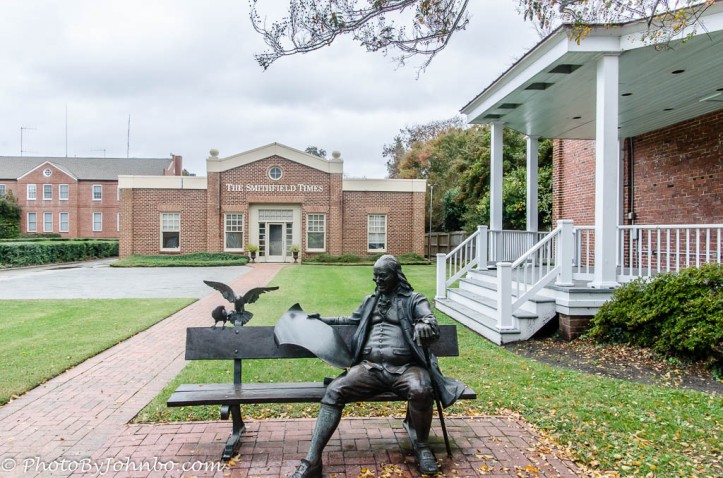Smithfield, Virginia.
It was the fall of 1637 when Arthur Smith reserved for development 1450 acres (5.9 sq. km) along the Pagan River in Isle of Wight County. Over a century later, Arthur Smith IV created the river town of Smithfield, often incorrectly identified with John Smith, the founder of Jamestown. On a cloudy day punctuated with periods of rain, my wife, Lynn, and I were given a tour of this historic town by my cousin, Brian Ashpole. In the image above, a statue of Ben Franklin reads the paper in front of the Smithfield Times building. The weekly newspaper has served the counties of Surry and Isle of Wight since 1920.
A frequent visitor, and an avid student of history, Brian was full of information on the significance of the area’s bygone times. The town’s historic preservation district features houses that predate the American Revolution in the late 18th century. Many homes, though, like the Victorian example in the photo above, were built shortly after the Civil War. It was a time of prosperity as the town grew with the help of a growing peanut industry and steamboats navigating the Pagan River.

Our first historic stop on the tour was the county’s first courthouse. Colonial Virginia’s Isle of Wight County originally held court in homes or taverns near Smithfield. In 1751, a county courthouse was completed in the town of Smithfield. In the courtyard, the stocks and pillory were used to publicly punish criminals. Repeat offenders had their earlobes nailed to the boards and when released, the nails were not removed, slitting the lobes and permanently marking the transgressor. More serious offenses were punishable by public lashings. The most serious crimes, however, were tried under the jurisdiction of colonial Williamsburg.
On the day of our visit, a volunteer provided an interpretive talk about the history and use of this courthouse during it’s 50 years of operation. In 1938, the building was scheduled for demolition. Fortunately a historic Virginia Preservation organization rescued the building from certain destruction. After several renovations and reconstructions, the last in 1998, the building is said to be a faithful reconstruction of a typical colonial courthouse.
Residents at the far end of the county eventually made themselves heard about the long distance and the time it took to travel to the county court. After only 50 years, the courthouse was moved to a more centrally located property, at that time owned by Francis Boykin. The tavern owner inherited the house and land in 1780. Knowing that having a courthouse next door to his tavern would be good for business, he donated the house to Isle of Wight County for use as a courthouse. Now a historic site, the courthouse museum is open for self-guided tours on a limited schedule. More background and museum information is located here. On our way back to my cousin’s home town of Suffolk, we passed the Boykin Courthouse and stopped to capture the image above.
On our walk through town, I couldn’t resist capturing a macro shot of someone’s front yard rose bush in bloom. Smithfield also has a rich Civil War history. In the battle of Smithfield, confederates captured 150 Union troops from the gunboat USS Smith-Briggs. Several important Civil War historic sites are located near the town. As I mentioned earlier, peanuts are an agricultural staple of the area. Planters Peanuts, then Planters Nut and Chocolate Company, opened a processing plant in nearby Suffolk, Virginia in 1913. The gallery of images below features sights captured in our walk along the main street of Smithfield, Virginia. Click on an image to enlarge it and to scroll through the gallery.
John Steiner














